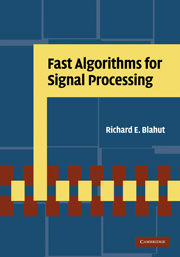Book contents
- Frontmatter
- Contents
- Preface
- Acknowledgments
- 1 Introduction
- 2 Introduction to abstract algebra
- 3 Fast algorithms for the discrete Fourier transform
- 4 Fast algorithms based on doubling strategies
- 5 Fast algorithms for short convolutions
- 6 Architecture of filters and transforms
- 7 Fast algorithms for solving Toeplitz systems
- 8 Fast algorithms for trellis search
- 9 Numbers and fields
- 10 Computation in finite fields and rings
- 11 Fast algorithms and multidimensional convolutions
- 12 Fast algorithms and multidimensional transforms
- A A collection of cyclic convolution algorithms
- B A collection of Winograd small FFT algorithms
- Bibliography
- Index
12 - Fast algorithms and multidimensional transforms
Published online by Cambridge University Press: 03 May 2011
- Frontmatter
- Contents
- Preface
- Acknowledgments
- 1 Introduction
- 2 Introduction to abstract algebra
- 3 Fast algorithms for the discrete Fourier transform
- 4 Fast algorithms based on doubling strategies
- 5 Fast algorithms for short convolutions
- 6 Architecture of filters and transforms
- 7 Fast algorithms for solving Toeplitz systems
- 8 Fast algorithms for trellis search
- 9 Numbers and fields
- 10 Computation in finite fields and rings
- 11 Fast algorithms and multidimensional convolutions
- 12 Fast algorithms and multidimensional transforms
- A A collection of cyclic convolution algorithms
- B A collection of Winograd small FFT algorithms
- Bibliography
- Index
Summary
In earlier chapters, we saw ways in which the Fourier transform can be broken into pieces and ways in which a convolution algorithm can be turned into an algorithm for the Fourier transform. It also is possible to break a multidimensional Fourier transform into pieces and to turn an algorithm for the multidimensional convolution into an algorithm for the multidimensional Fourier transform. The possibilities now are even richer than they were in the one-dimensional case. We shall discuss a variety of methods.
The algorithms for multidimensional Fourier transforms are studied in the easy way by studying only the algorithms for the two-dimensional Fourier transform as representative of the more general case. The discussion and the formulas for the two-dimensional Fourier transforms can be extended directly to a discussion of the multidimensional Fourier transforms.
Multidimensional Fourier transforms arise naturally from problems that are intrinsically multidimensional. They also arise artificially as a way of computing a one-dimensional Fourier transform. This chapter includes such methods for computing a one-dimensional Fourier transform, and so we will give practical methods for building large one-dimensional Fourier transform algorithms from the small one-dimensional Fourier transform algorithms that were studied in Chapter 3.
Small-radix Cooley–Tukey algorithms
A two-dimensional discrete Fourier transform can be computed by applying the Cooley–Tukey FFT first to each row and then to each column.
- Type
- Chapter
- Information
- Fast Algorithms for Signal Processing , pp. 384 - 426Publisher: Cambridge University PressPrint publication year: 2010



